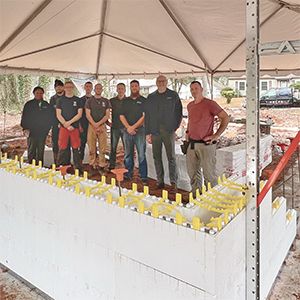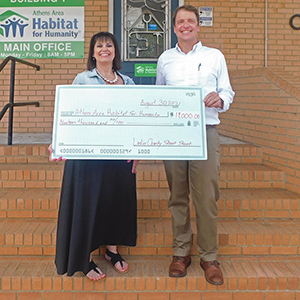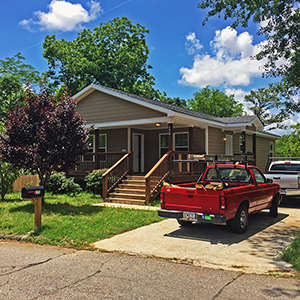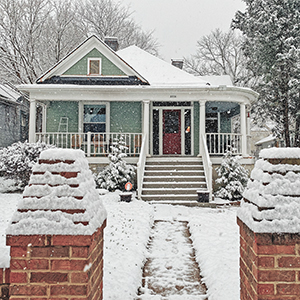Upbuilding: Winter 2021-22


Building the Community | The Giving Spirit | Volunteer Spotlight | Local Partners | What We’re Up To | Homeowner Tips
Greetings, Habitat nation! It’s been a long year, in many ways a difficult year, but also a hopeful one for us. We’ve faced new variants of the covid virus, supply shortages, cost increases, and steep learning curves. But we’ve also been blessed with strong local support, productive partnerships, and an amazingly determined team. Here’s a look back over the latter half of 2021…
(If you’re not already receiving notice of our newsletters by email, just click here to sign up for notifications in your inbox when each new edition is published. You’re free to unsubscribe at any time.)
Building the Community

Athens, GA, is one of just 16 cities nationwide selected by the Build With Strength coalition for a partnership with Habitat for Humanity. Which means we’re adding concrete construction to our toolbelt!
When you think of building with concrete you probably imagine skyscrapers, arenas, factories, and other large structures like that. But these days, concrete can be used for buildings of any size. And you wouldn’t necessarily know they were made with concrete just to look at them.
The secret lies in “insulated concrete forms” (or ICFs) like those in the photograph manufactured by Quad-Lock. They snap together a bit like Lego bricks, and are aligned with Plumwall braces (visible at far right). Concrete is poured around a mesh of vertical and horizontal rebar inside the space between the forms, then any sort of wall treatment you like can be installed on the interior and exterior, which in this case will be drywall and Hardie plank respectively.
The soaring cost of lumber has made concrete price-competitive with “stick” construction. And working with ICFs greatly reduces the labor-hours needed to build the home, bringing costs down even further. Once it’s complete, the new homeowner will enjoy as much as 60% greater energy efficiency compared to framed homes, lowering the cost of home-ownership. Plus, the home will be much quieter to live in, and will stand up to storms and other natural disasters in ways that framed houses simply cannot. (We have photos in our lobby of concrete homes still standing amid the rubble of hurricanes!)
But we don’t want to be the only ones in our area using this technology. That’s why we’re inviting area builders onto the site to see first-hand how it’s done. And we’re advocating for an insurance break for homeowners living in ICF houses, so that the savings incurred through lowered risk get passed along to home buyers. Someday soon, we’d like to build an entire neighborhood with ICFs!
The Giving Spirit
We’re currently in the middle of our annual fund drive, the time of year when we depend on our local supporters to contribute financially to the future of Habitat for Humanity in our area. Recently our staff, volunteers, and members of our board of directors got together to record a message for everyone who helps us do what we do, explaining how your various gifts build our community.
If you haven’t yet made a contribution to our annual fund drive, we hope you’ll consider doing so now. Just click the button below to get started. Thanks!
Volunteer Spotlight
Most folks who volunteer with Habitat come out to our build sites a few weekends a year. Then there are those who become “regulars,” usually applying career skills to assist our mission. One such volunteer is John Hardy, who gives of his time and expertise in our ReStore thrift shops to repair and sell donated items which, without his help, we’d be forced to discard.
If you have skills that you’d like to put to use improving our community by helping Habitat achieve its mission of providing strength, stability, and self-reliance through shelter — whether on our build sites, at our thrift stores, or in our affiliate office — we’d love to hear from you! Just check out our volunteering page and give us a shout any time.
Local Partners

Ever since the Ladies Charity Skeet Classic moved to Georgia, organizers Tami and Al Means have raised five-figure contributions to Athens Habitat every year that the event has been held. This year, despite the ongoing pandemic and related travel concerns, $19,000 was raised to support our mission.
Targets-n-Tiaras is the organization behind this national skeet shooting tournament, which draws competitors from all over the country. The Meanses have a long history with the Habitat organization, and we count them among our most fervent and reliable supporters.
What’s been amazing for us is to also see how dedicated the tournament participants are to this event and its cause. Many of them are active with Habitat affiliates in their own hometowns as well, and they’re keenly interested in the projects they’re supporting and the families who will be moving into the homes they help build.
They take it personally, too! Not only do they support Athens Area Habitat with their tournament fees, they raise additional funds by contributing items to the tournament auction — everything from manufactured items used in the sport to handmade items and gift baskets crafted by the women on their own time. These folks embody the true spirit of American charity, giving of themselves in so many ways to help others. Our hardhats are off to everyone involved in the LCSC, but especially to Tami and Al without whose hard work there would be no event to celebrate.
What We’re Up To

For the past three years or so, we’ve been working on a dream — an entire neighborhood of more than 60 owner-occupied homes in Athens-Clarke County, in a school district with one of the lowest home ownership rates in the country. Plus, a longitudinal study by UGA to measure the impact of the project so that it can be replicated by other Habitat affiliates around the state and the nation.
We’re calling this vision “Micah’s Creek,” after the Hebrew prophet who asked the immortal question, “what does the Lord require of you but to do justice, and to love mercy, and to walk humbly with your God?” And this year, that vision came more than a few steps closer to reality.
While we don’t yet know if our project will be selected, we recently completed and submitted applications for grant funding that would put us over the top and enable us to tackle our most ambitious project to date. In the process, we attracted new partners, performed more in-depth research, and refined our plans even further.
We’d love to put our new skills from the Build With Strength project to work on Micah’s Creek. So we’re hoping for good news soon.
But if we don’t succeed on this round, we’re prepared to keep refining, keep applying, and continue creating new and productive partnerships until the funds are available to achieve our goal. That’s because we believe the ambition of a non-profit should not be scaled to the size its local population, but rather to the scope of the local need. And right now, Athens-Clarke County has among the highest poverty rates and lowest home ownership rates in the United States. Our mission is to help change that, and making Micah’s Creek a reality will mark a quantum leap in our contribution to bettering the lives of our neighbors and improving our local economy. So stay tuned, folks!
Homeowner Tips

Winter is upon us! Here are a few tips to help you weather the season in comfort and safety….
Turn on your fans: Yup, ceiling fans can actually be used to help keep you warm in winter, and reduce power bills, especially in Southern homes with high ceilings. The trick is to switch the direction of the fan from its summer setting (usually from counter-clockwise to clockwise as viewed from the floor) so that the blades are pushing air up rather than down, and setting the fan to run continuously on low. The fan will then create a vacuum effect in the space beneath it by pushing air upward and, as it blows against the ceiling, outward toward the walls where it sinks as air from the center of the room is forced upward. This keeps warm air from rising to the top of the room and staying there, trapping colder air beneath it, by keeping it in circulation. At the same time, the low setting and upward direction prevents the fan from creating a chilly breeze.
Wrap your pipes: If you have exposed water pipes in a vented crawl space, which most folks do around here, you can save money and possibly even avoid disaster simply by wrapping those pipes with inexpensive insulation. A chilly crawl space with exposed pipework means heat loss, which also means you have to raise the temperature of your water heater in winter to get the same temperature of hot water out of your tap or shower head as you get in summer. Insulating those pipes allows you to keep the thermostat on your water heater at a lower setting in cold months. And if there’s a long hard freeze, it could even prevent your pipes from bursting! (As to whether you should close your foundation vents in winter, that’s a matter of considerable debate and depends upon factors such as whether you have a ground vapor barrier and what your radon levels are. We recommend knowing your home’s specs and doing a little research before deciding.)
Dodge the draft: Lots of older Southern homes have gaps under doors and windows that can let a considerable amount of cold air in. One of the simplest and least costly ways to stop these drafts is to make “draft dodgers” to block the gaps. You can make your own with scraps of fabric and inexpensive fillers such as rice, coarse sand, or cat litter. Here’s a complete set of directions that we like: How To Make a Draft Dodger for Doors and Windows. Get creative and have fun with it!

